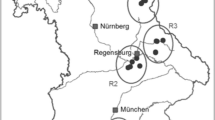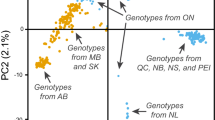Abstract
Native populations of perennial grasses subjected to heavy grazing are typically shorter and more prostrate than ungrazed or lightly defoliated ones. However, it is often difficult to find out whether the morphological modifications are the result of genetic differentiation or phenotypic plasticity. Piptochaetium napostaense (Speg.) Hack. is a native perennial cool-season palatable grass with a dwarf form abundant in the areas subjected to heavy grazing. In this study, we tried to determine whether the populations with different grazing histories are genetically differentiated. We considered three different grazing conditions: enclosure (prevented from grazing during 20 years), livestock grazing, and burrow (heavily grazed by cattle and a wild rodent herbivore, the vizcacha). Isozyme analyses were carried out in order to assess the genetic variability of the populations under study. We further studied the progeny of plants with different grazing histories to determine whether the morphological differences are transmitted to the next generation. Seedlings obtained from seeds belonging to enclosure and burrow were grown in the greenhouse and their vegetative and reproductive response under different water and nutrient availability levels were recorded. From the isozymes analyses we found low levels of genetic variation in the populations studied, with an average of 20.5% polymorphic loci, 1.2 alleles per locus and 0.015 mean expected heterozygosity. From the total genetic diversity, only 1.4% was due to differences among population. In addition, either enclosure or burrow populations had the same growth and reproductive response over treatments differing in water and nutrient levels. The morphological differentiation among plants with different grazing histories appears to be the outcome of a phenotypically plastic response of adapted genotypes.
Similar content being viewed by others
References
Ainouche, M., Misset, M. & Houn, A. 1996. Patterns of genetic differentiation in two annual bromegrasses, Bromus lanceolatus and B. hordeaceun (Poaceae) Pl. Syst. Evol. 199: 68–78.
Allard, R., Babbel, G., Clegg, M. & Kahler, A. 1972. Evidence for coadaptation in Avena barbata. Proc. Natl. Acad. Scis. USA 69: 3043–3048.
Archer, S. R. & Tieszen, L. L 1986. Plant response to defoliation: hierarchical considerations In: Olafur Gudmundsson (eds), Grazing research at northern latitudes. Plenum Publishing Corporation.
Bradshaw, A. D. 1965. Evolutionary significance of phenotypic plasticity in plants. Adv. Genet. 13: 115–155.
Branch, L. 1993. Intergroup and intragroup spacing in the plains vizcacha, Lagostomus maximus. J. Mamm. 74(4): 890–900.
Briske, D. D. 1989. Developmental morphology and physiology of grasses. pp. 85–109. In: Heitschmidt & Studh (eds), Grazing management. An ecological perspective. Timber Press, Portland, Oregon.
Briske, D. & Anderson, V. 1992. Competitive ability of the bunchgrass Schizachyrium scoparium as affected by grazing history and defoliation. Vegetatio 103: 41–49.
Bush, E. J. & Barrett, S. C. 1993. Genetics of mine invasions by Deschampsia cespitosa (Poaceae) Can. J. Bot. 71: 1336–1348.
Busso, C. 1997 Towards an increased and sustainable production in semiarid rangelands of Central Argentina: Two decades of research. J. Arid. Env. 36: 197–210.
Cabrera, A. L. 1970. Flora de la Provincia de Buenos Aires. Parte II. Gramineas. Coleccion Cientifica INTA.
Cabrera, A. L. 1976. Regiones fitogeográficas argentinas In Enciclopedia argentina de agricultura y jardineria (Tomo II). ACME, Buenos Aires.
Carman, J. & Briske, D. 1985. Morphologic and allozymic variation between long-term grazed and non-grazed populations of the bunchgrass Schizachyrium scoparium var. frequens. Oecologia (Berlin) 66: 332–337.
Coughenour, M. 1985. Graminoid responses to grazing by large herbivores: adaptations, exaptations, and interacting processes. Ann. Missouri Bot. Gard. 72: 852–863.
Detling, J. K. & Painter, D. L. 1983. Defoliation responses of western wheatgrass populations with diverse histories of prairie dog grazing. Oecologia (Berlin) 57: 65–71.
Distel, R. & Boo, R. 1996. Vegetation states and transitions in temperate semi-arid rangeland of Argentina. In: West, N. (ed), Proceedings of the Fifth International Rangeland Congress. Salt Lake City, Utah, USA.
Distel, R. A. & Fernandez, O. A. 1986. Productivity of Stipa tenuis Phil and Piptochaetium napostaense (Speg.) Hack. in semi-arid Argentina. J. Arid Environ. 11: 93–96.
Distel, R. A., Pelaez, D. V. & Fernandez, O. A. 1992. Germination of Piptochaetium napostaense (Speg.) Hackel and Stipa tenuis Phil. and seedling survival under field conditions. Rangeland J. 14: 49–55.
Gray, J. & Scott, R. 1980. A genecological study of Puccinellia maritima Huds. (Parl.) New Phytol. 85: 89–107.
Gehring, J. & Linhart, Y. 1992. Population structure and genetic differentiation in native and introduced populations of Deschampsia caespitosa (Poaceae) in the Colorado Alpine Am. J. Bot. 79(12): 1337–1343.
Gottlieb, L. D. 1981. Electrophoretic evidence and plant populations. Progress Phytochemistry. Vol. 7.
Hamrick, J. L. 1989. Isozymes and the analysis of genetic structure in Plant Populations. In: Soltis, D.E. & Soltis, P.S. (eds), Isozymes in plant biology. Dioscorides Press, Portland, OR.
Hamrick, J. L. & Godt, M. J. 1990. Allozyme diversity in plant species. pp. 43–63. In: A.H.D. Brown, M. T. Clegg, A. L. Kahler & B. S. Weir (eds), Plant population genetics, breeding and genetic resources, Sinauer, Sunderland, MA.
Hamrick, J. L. & Holden, L. R. 1979. Influence of microhabitat heterogeneity on gene frequency distribution and gametic phase disequilibrium in Avena barbata. Evolution 33(2): 521–533.
Hickey, W. 1961. Growth form of crested wheatgrass as affected by site and grazing. Ecology 42(1): 173–176.
Hurka, H. 1993. Isozymes in population genetic studies. In: Lieth, H. & Massom, A. (eds), Towards the rational use of high salinity tolerant plants. Vol 2. Kluwer Academic Publishers, Dordrecht, pp. 75–82.
Ibañ ez, M., Di Renzo, M. & Poverene, M. 1994. Isozymic polymorphisms in a diploid population of lovegrass (Eragrostis curvula). J. Genet Breed. 48: 141–148.
Linhart, Y. & Grant, M. 1996. Evolutionary significance of local genetic differentiation in plants. Ann. Rev. Ecol. Syst. 27: 237–277.
Mahmoud, A., Grime, J. & Furness, S. 1975. Polymorphism in Arrhenatherum elatius (L.) Biauv. ex J. & C. Presl. New Phytol. 75: 269–276.
McNaughton, S. J. 1979. Grazing as an optimization process. Grassungulate relationships in Serengeti. Am. Nat. 113: 691–703.
McKinney, K. & Flower, N. 1991. Genetic adaptation to grazing and mowing in the unpalatable grass Cenchrus incertus. Oecologia. 88: 238–242.
McNeilly, T. 1981. Ecotypic differentiation in Poa annua: interpopulation differences in response to competition and cutting. New Phytol. 88, 539–547.
Mitton, J. B. 1994. Molecular approaches to population biology. Annu. Rev. Ecol. Syst. 25: 45–69.
Nei, M. 1978. Estimation of average heterozygosity and genetic distance from a small number of individuals. Genetics 89: 583–590.
Nevo, E., Zohary, D., Brown, A. H. D. & Harber, M. 1979. Genetic diversity and environmental associations of wild barley, Hordeum spontaneum, in Israel. Evolution. 33(3): 815–833.
Nevo, E., Beiles, A., Kaplan, D., Golenberg, E. M., Olsvig-Whittaker, L. & Naveh, Z. 1986. Natural selection of allozyme polymorphisms: a microsite test revealing ecological genetic differentiation in wild barley. Evolution. 40(1): 13–20.
Ollejonsson, B., Jonsdöttir, I. & Cronberg, N. 1996. Clonal diversity and allozyme variation in populations of artid sedge Carex bigelowii (Cyperaceae) J. Ecol. 84: 449–459.
Reynolds H. & D'Antonio, C. 1996. The ecological significance of plasticity in root weight ratio in response to nitrogen: Opinion. Plant Soil 185: 75–97.
Schlichting, C. 1986. The evolution of phenotypic plasticity in plants. Ann. Rev. Ecol Syst. 17: 667–693.
Schlichting, C. & Pigliucci M. 1995 Gene regulation, quantitative genetics and the evolution of reaction norms. Evol. Ecol. 9: 154–168.
Snaydon, R. W. 1985. Aspects of the ecological genetics of pasture species. In: Haeck, J. and Woldendorp, J.W. (eds.), Structure and functioning of plant populations /2. North-Holland Publishing Company, Amsterdam, pp. 127–152.
Swofford, D. L. & Selander, R. B. 1989. BIOSYS-1 A computer program for the analysis of allelic variation in population genetic and biochemical systematics, Illinois Natural History Survey.
Trlica, M. J. & Orodho, A. P. 1989. Effects of protection form grazing on mophological and chemical characteristics of Indian ricegrass, Oryzopsis humenoides. Oikos 56: 299–308.
Valencia, J. & Costas, M. 1968. Estudios citotaxonomicos sobre Piptochaetium (Gramineae). Bol. Soc. Argentina Bot. XII: 167–179.
Warwick, S. & Briggs, D. 1978. The genecology of lawn weeds. New Phytol. 81: 725–737.
Weibull, P., Ghatnekar, L. & Bengtsson, B. O. 1991. Genetic variation in commercial varieties and natural populations of sheep's fescue, Festuca ovina s.l. Plant Breed 107: 203–209.
Wendel, J. F. & Weeden, N. F. 1989. Visualization and interpretation of plant isozymes. Pp. 5–45. In: Soltis, D. E. & Soltis, P. S. (eds), Isozymes in plant biology. Dioscorides Press, Portland, OR.
Whicker, A. D. & Detling, J. K. 1988. Ecological consequences of prairie dog disturbances. BioScience. 38(11): 778–785.
Workman P. & Niswander J. 1970. Population studies on Southwestern Indian Tribes II. Local genetic differentiation in the Papago. Am. J. Human Genetics. 22: 24–49.
Wright, S. 1978. Evolution and the genetics of populations, vol. 4: variability within and among natural populations. University of Chicago Press, Chicago, IL.
Author information
Authors and Affiliations
Rights and permissions
About this article
Cite this article
Tomás, M.A., Carrera, A.D. & Poverene, M. Is there any genetic differentiation among populations of Piptochaetium napostaense (Speg.) Hack (Poaceae) with different grazing histories?. Plant Ecology 147, 227–235 (2000). https://doi.org/10.1023/A:1009856732262
Issue Date:
DOI: https://doi.org/10.1023/A:1009856732262




